steering wheel FORD GT 2006 1.G Owners Manual
[x] Cancel search | Manufacturer: FORD, Model Year: 2006, Model line: GT, Model: FORD GT 2006 1.GPages: 200, PDF Size: 1.86 MB
Page 1 of 200
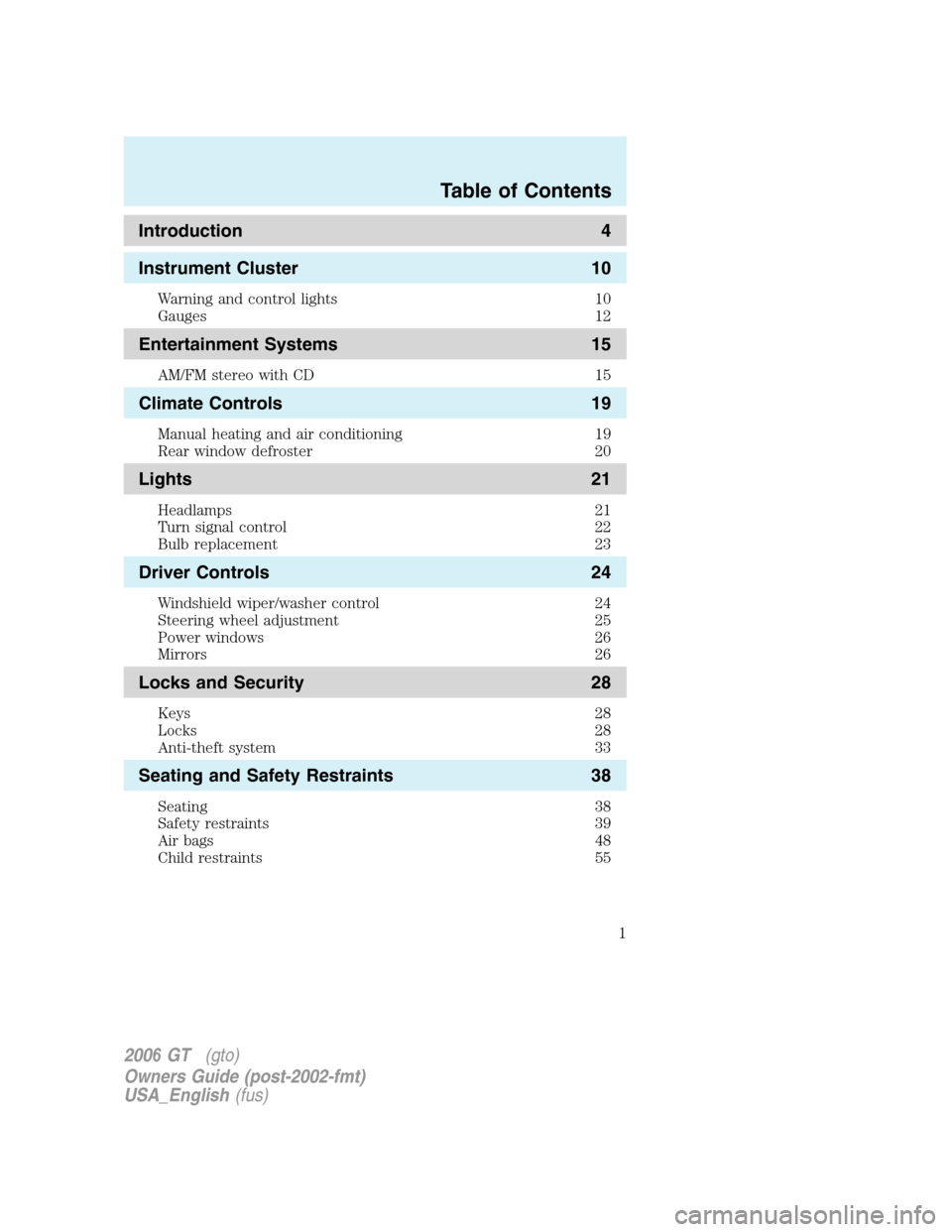
Introduction 4
Instrument Cluster 10
Warning and control lights 10
Gauges 12
Entertainment Systems 15
AM/FM stereo with CD 15
Climate Controls 19
Manual heating and air conditioning 19
Rear window defroster 20
Lights 21
Headlamps 21
Turn signal control 22
Bulb replacement 23
Driver Controls 24
Windshield wiper/washer control 24
Steering wheel adjustment 25
Power windows 26
Mirrors 26
Locks and Security 28
Keys 28
Locks 28
Anti-theft system 33
Seating and Safety Restraints 38
Seating 38
Safety restraints 39
Air bags 48
Child restraints 55
Table of Contents
1
2006GT (gto)
Owners Guide (post-2002-fmt)
USA_English (fus)
Table of Contents
Page 7 of 200
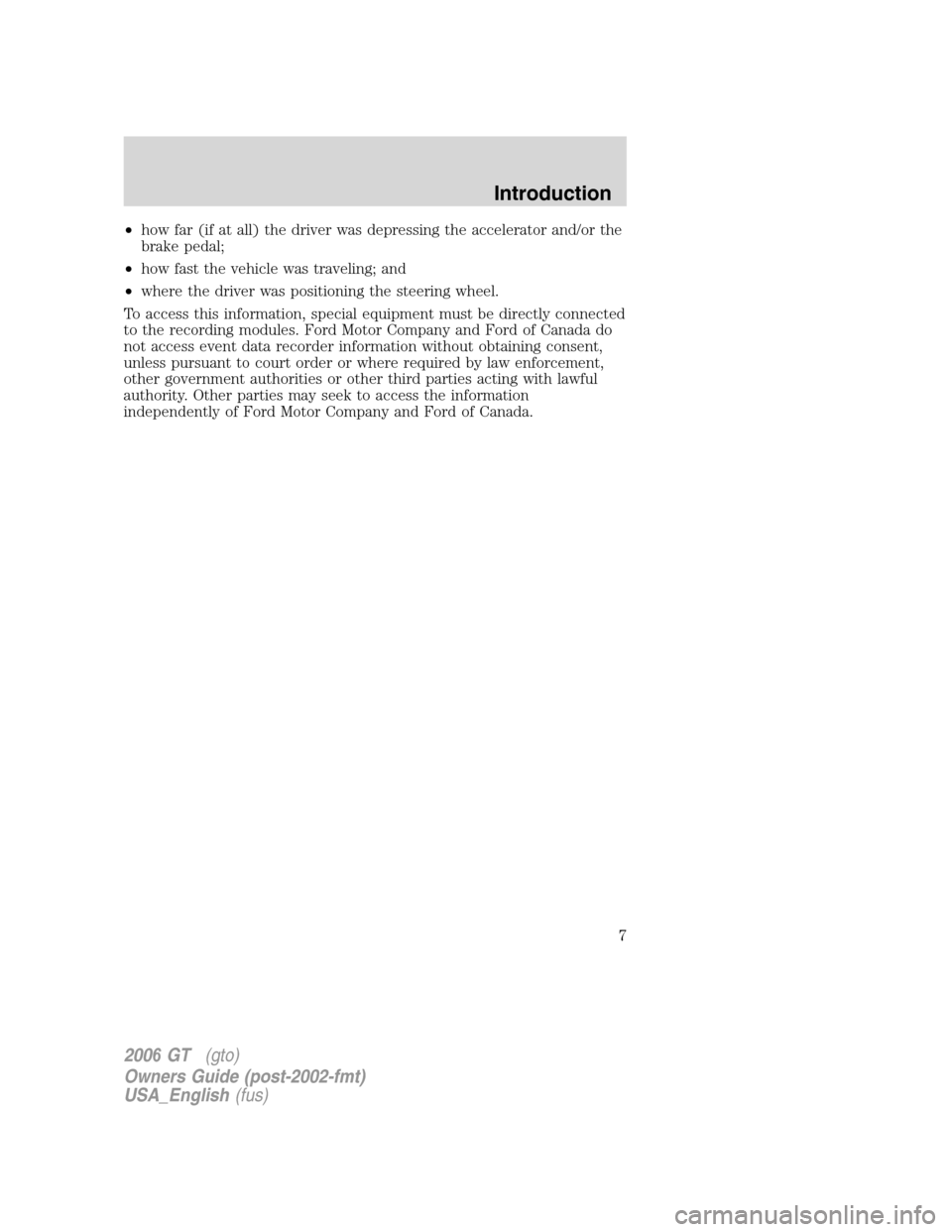
•how far (if at all) the driver was depressing the accelerator and/or the
brake pedal;
• how fast the vehicle was traveling; and
• where the driver was positioning the steering wheel.
To access this information, special equipment must be directly connected
to the recording modules. Ford Motor Company and Ford of Canada do
not access event data recorder information without obtaining consent,
unless pursuant to court order or where required by law enforcement,
other government authorities or other third parties acting with lawful
authority. Other parties may seek to access the information
independently of Ford Motor Company and Ford of Canada.
2006 GT (gto)
Owners Guide (post-2002-fmt)
USA_English (fus)
Introduction
7
Page 25 of 200
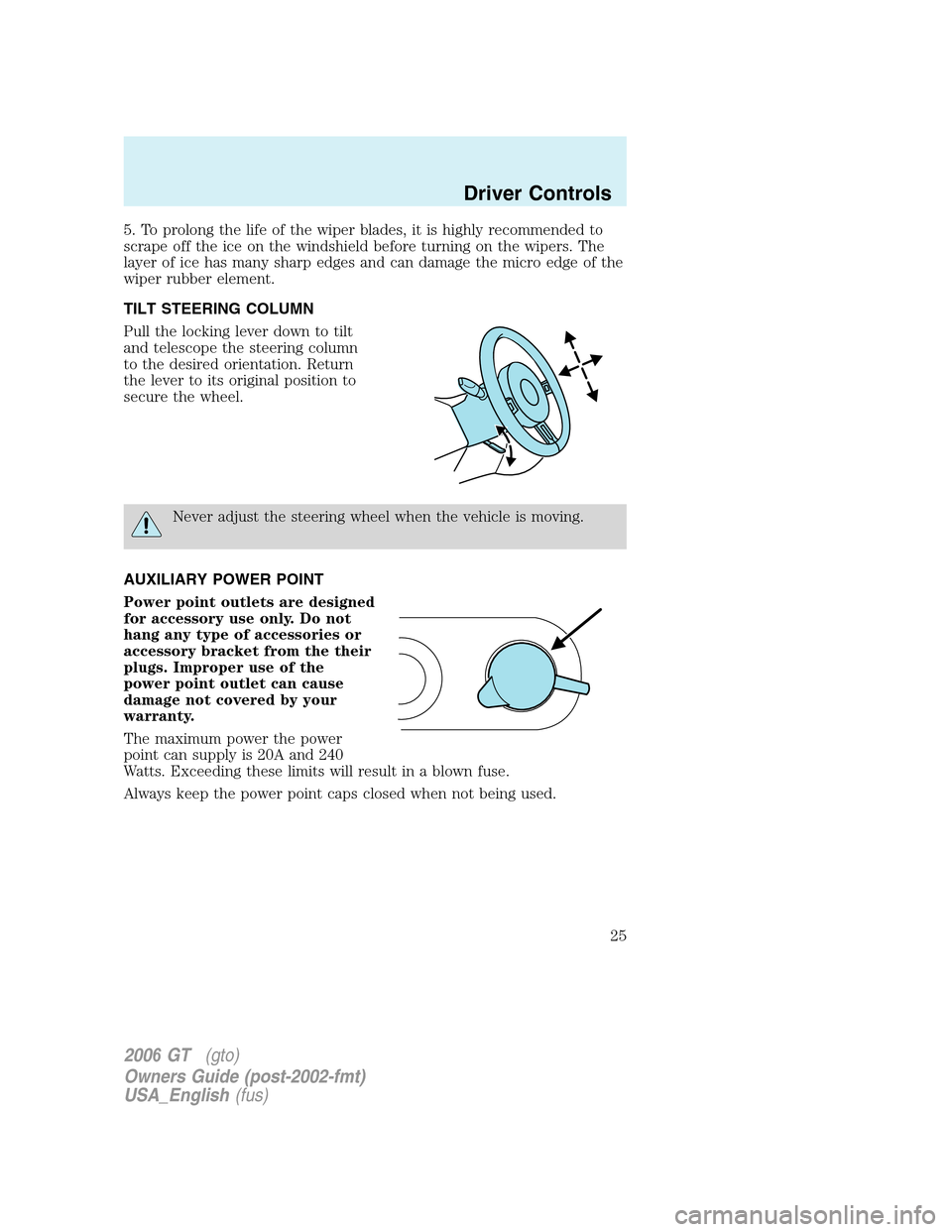
5. To prolong the life of the wiper blades, it is highly recommended to
scrape off the ice on the windshield before turning on the wipers. The
layer of ice has many sharp edges and can damage the micro edge of the
wiper rubber element.
TILT STEERING COLUMN
Pull the locking lever down to tilt
and telescope the steering column
to the desired orientation. Return
the lever to its original position to
secure the wheel.
Never adjust the steering wheel when the vehicle is moving.
AUXILIARY POWER POINT
Power point outlets are designed
for accessory use only. Do not
hang any type of accessories or
accessory bracket from the their
plugs. Improper use of the
power point outlet can cause
damage not covered by your
warranty.
The maximum power the power
point can supply is 20A and 240
Watts. Exceeding these limits will result in a blown fuse.
Always keep the power point caps closed when not being used.
2006 GT (gto)
Owners Guide (post-2002-fmt)
USA_English (fus)
Driver Controls
25
Page 71 of 200
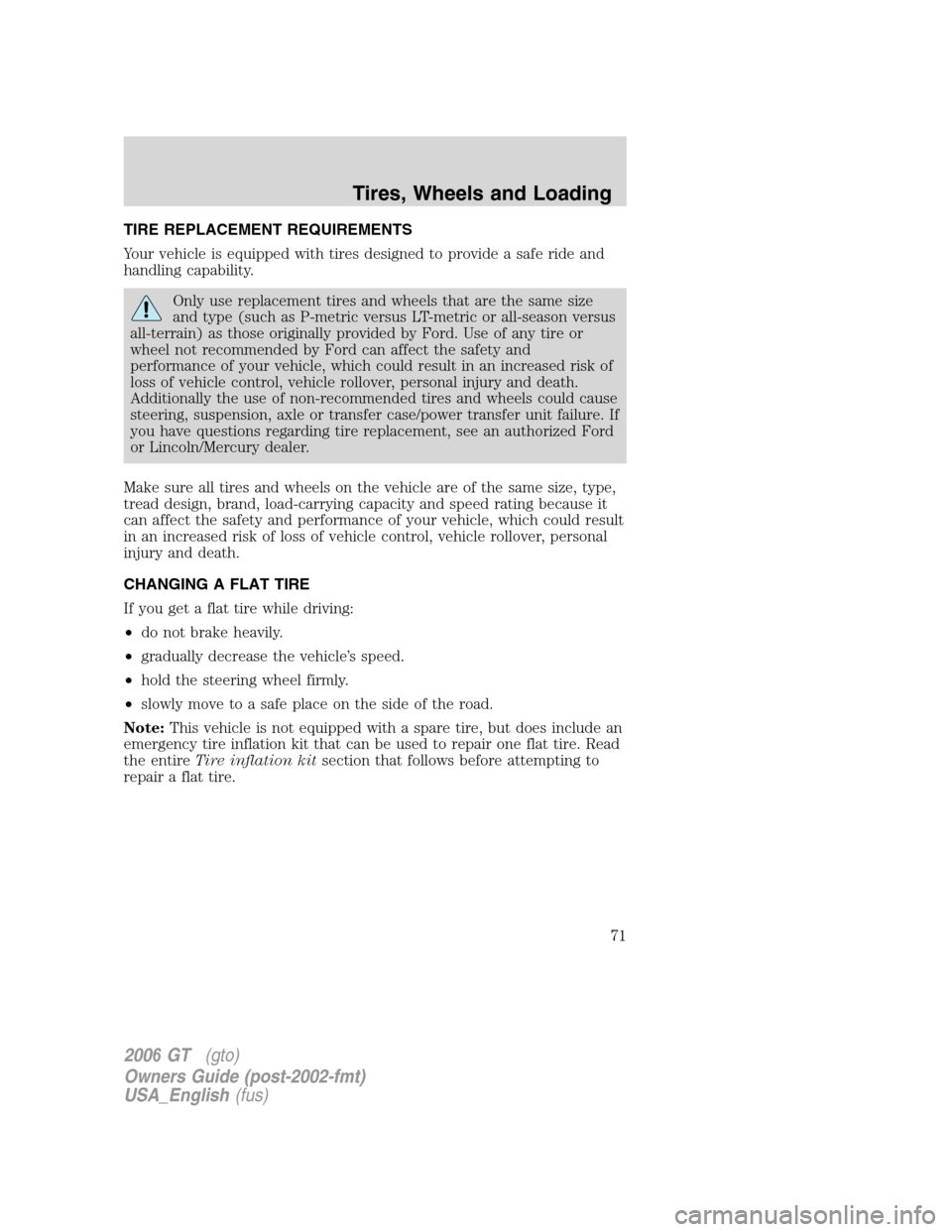
TIRE REPLACEMENT REQUIREMENTS
Your vehicle is equipped with tires designed to provide a safe ride and
handling capability.
Only use replacement tires and wheels that are the same size
and type (such as P-metric versus LT-metric or all-season versus
all-terrain) as those originally provided by Ford. Use of any tire or
wheel not recommended by Ford can affect the safety and
performance of your vehicle, which could result in an increased risk of
loss of vehicle control, vehicle rollover, personal injury and death.
Additionally the use of non-recommended tires and wheels could cause
steering, suspension, axle or transfer case/power transfer unit failure. If
you have questions regarding tire replacement, see an authorized Ford
or Lincoln/Mercury dealer.
Make sure all tires and wheels on the vehicle are of the same size, type,
tread design, brand, load-carrying capacity and speed rating because it
can affect the safety and performance of your vehicle, which could result
in an increased risk of loss of vehicle control, vehicle rollover, personal
injury and death.
CHANGING A FLAT TIRE
If you get a flat tire while driving:
• do not brake heavily.
• gradually decrease the vehicle’s speed.
• hold the steering wheel firmly.
• slowly move to a safe place on the side of the road.
Note: This vehicle is not equipped with a spare tire, but does include an
emergency tire inflation kit that can be used to repair one flat tire. Read
the entire Tire inflation kit section that follows before attempting to
repair a flat tire.
2006 GT (gto)
Owners Guide (post-2002-fmt)
USA_English (fus)
Tires, Wheels and Loading
71
Page 73 of 200
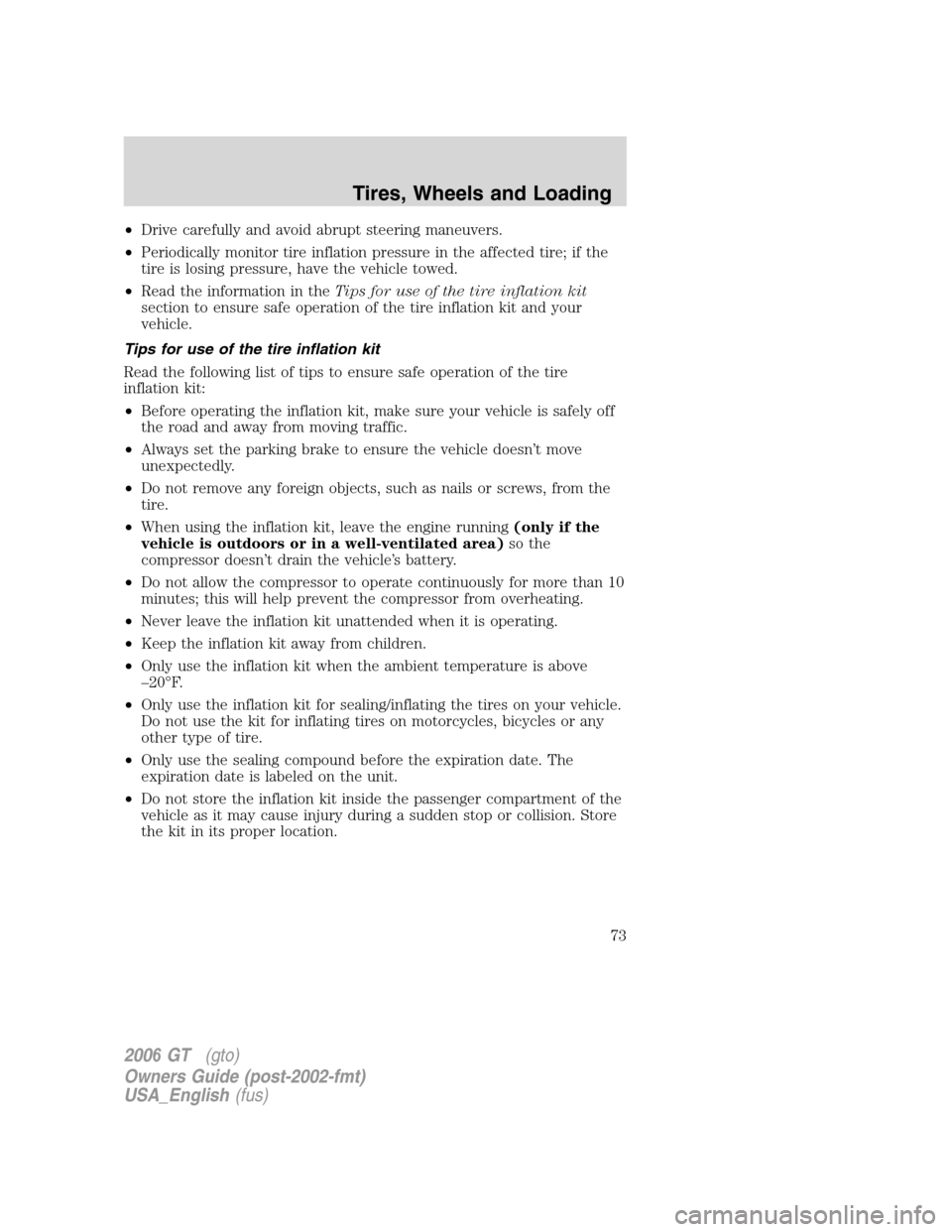
•Drive carefully and avoid abrupt steering maneuvers.
• Periodically monitor tire inflation pressure in the affected tire; if the
tire is losing pressure, have the vehicle towed.
• Read the information in the Tips for use of the tire inflation kit
section to ensure safe operation of the tire inflation kit and your
vehicle.
Tips for use of the tire inflation kit
Read the following list of tips to ensure safe operation of the tire
inflation kit:
• Before operating the inflation kit, make sure your vehicle is safely off
the road and away from moving traffic.
• Always set the parking brake to ensure the vehicle doesn’t move
unexpectedly.
• Do not remove any foreign objects, such as nails or screws, from the
tire.
• When using the inflation kit, leave the engine running (only if the
vehicle is outdoors or in a well-ventilated area) so the
compressor doesn’t drain the vehicle’s battery.
• Do not allow the compressor to operate continuously for more than 10
minutes; this will help prevent the compressor from overheating.
• Never leave the inflation kit unattended when it is operating.
• Keep the inflation kit away from children.
• Only use the inflation kit when the ambient temperature is above
–20°F.
• Only use the inflation kit for sealing/inflating the tires on your vehicle.
Do not use the kit for inflating tires on motorcycles, bicycles or any
other type of tire.
• Only use the sealing compound before the expiration date. The
expiration date is labeled on the unit.
• Do not store the inflation kit inside the passenger compartment of the
vehicle as it may cause injury during a sudden stop or collision. Store
the kit in its proper location.
2006GT (gto)
Owners Guide (post-2002-fmt)
USA_English (fus)
Tires, Wheels and Loading
73
Page 75 of 200
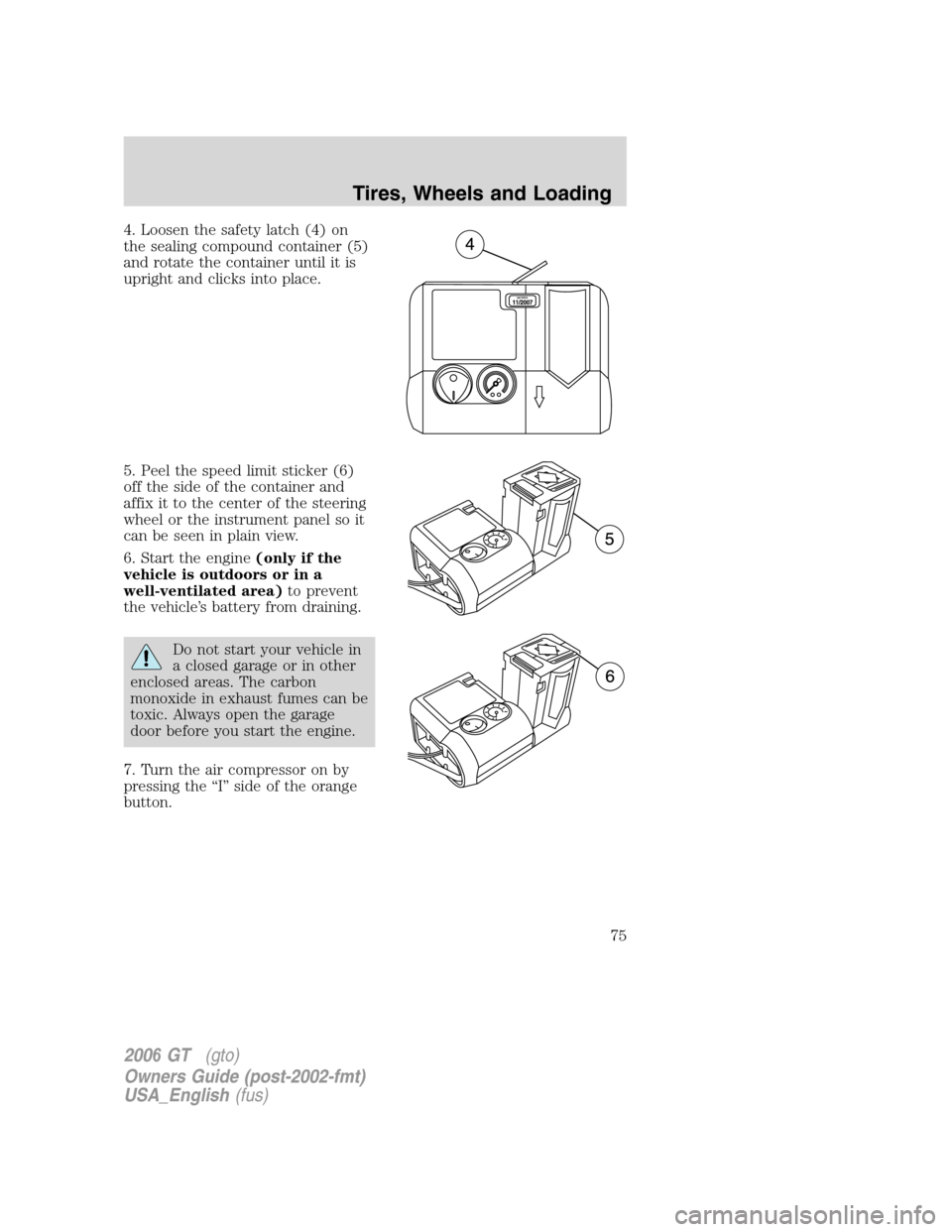
4. Loosen the safety latch (4) on
the sealing compound container (5)
and rotate the container until it is
upright and clicks into place.
5. Peel the speed limit sticker (6)
off the side of the container and
affix it to the center of the steering
wheel or the instrument panel so it
can be seen in plain view.
6. Start the engine(only if the
vehicle is outdoors or in a
well-ventilated area) to prevent
the vehicle’s battery from draining.
Do not start your vehicle in
a closed garage or in other
enclosed areas. The carbon
monoxide in exhaust fumes can be
toxic. Always open the garage
door before you start the engine.
7. Turn the air compressor on by
pressing the “I” side of the orange
button.
2006 GT (gto)
Owners Guide (post-2002-fmt)
USA_English (fus)
Tires, Wheels and Loading
75
Page 86 of 200
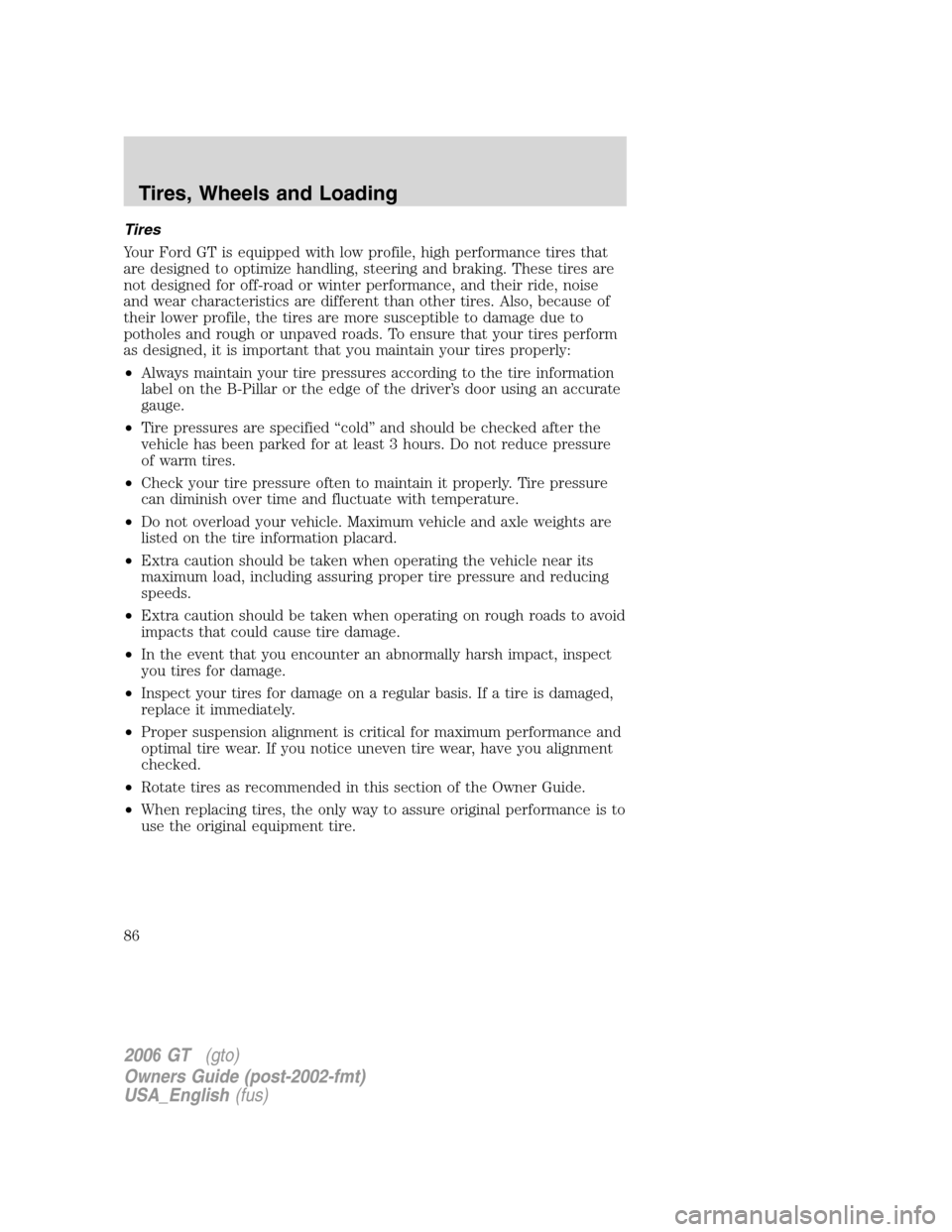
Tires
Your Ford GT is equipped with low profile, high performance tires that
are designed to optimize handling, steering and braking. These tires are
not designed for off-road or winter performance, and their ride, noise
and wear characteristics are different than other tires. Also, because of
their lower profile, the tires are more susceptible to damage due to
potholes and rough or unpaved roads. To ensure that your tires perform
as designed, it is important that you maintain your tires properly:
•Always maintain your tire pressures according to the tire information
label on the B-Pillar or the edge of the driver’s door using an accurate
gauge.
• Tire pressures are specified “cold” and should be checked after the
vehicle has been parked for at least 3 hours. Do not reduce pressure
of warm tires.
• Check your tire pressure often to maintain it properly. Tire pressure
can diminish over time and fluctuate with temperature.
• Do not overload your vehicle. Maximum vehicle and axle weights are
listed on the tire information placard.
• Extra caution should be taken when operating the vehicle near its
maximum load, including assuring proper tire pressure and reducing
speeds.
• Extra caution should be taken when operating on rough roads to avoid
impacts that could cause tire damage.
• In the event that you encounter an abnormally harsh impact, inspect
you tires for damage.
• Inspect your tires for damage on a regular basis. If a tire is damaged,
replace it immediately.
• Proper suspension alignment is critical for maximum performance and
optimal tire wear. If you notice uneven tire wear, have you alignment
checked.
• Rotate tires as recommended in this section of the Owner Guide.
• When replacing tires, the only way to assure original performance is to
use the original equipment tire.
2006GT (gto)
Owners Guide (post-2002-fmt)
USA_English (fus)
Tires, Wheels and Loading
86
Page 95 of 200
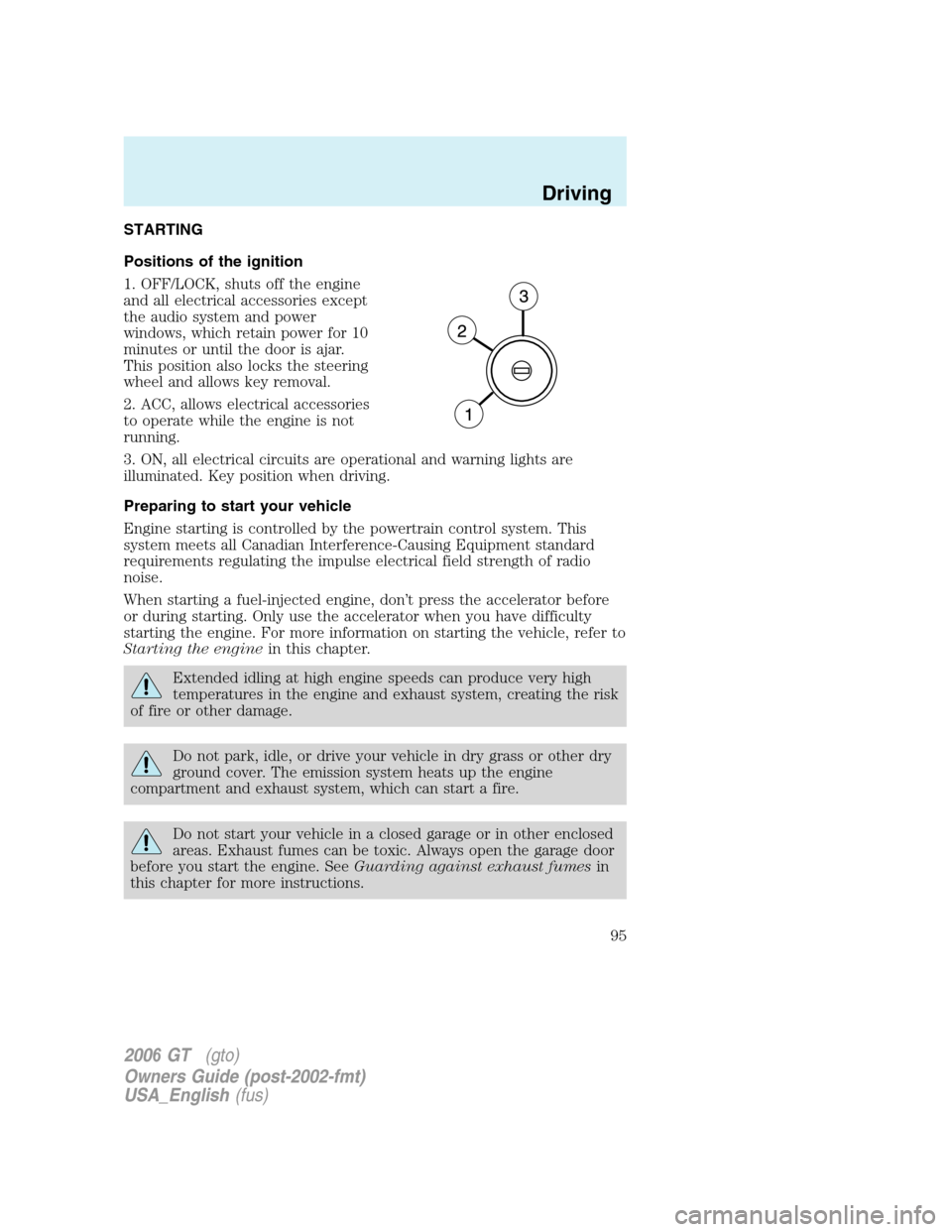
STARTING
Positions of the ignition
1. OFF/LOCK, shuts off the engine
and all electrical accessories except
the audio system and power
windows, which retain power for 10
minutes or until the door is ajar.
This position also locks the steering
wheel and allows key removal.
2. ACC, allows electrical accessories
to operate while the engine is not
running.
3. ON, all electrical circuits are operational and warning lights are
illuminated. Key position when driving.
Preparing to start your vehicle
Engine starting is controlled by the powertrain control system. This
system meets all Canadian Interference-Causing Equipment standard
requirements regulating the impulse electrical field strength of radio
noise.
When starting a fuel-injected engine, don’t press the accelerator before
or during starting. Only use the accelerator when you have difficulty
starting the engine. For more information on starting the vehicle, refer to
Starting the enginein this chapter.
Extended idling at high engine speeds can produce very high
temperatures in the engine and exhaust system, creating the risk
of fire or other damage.
Do not park, idle, or drive your vehicle in dry grass or other dry
ground cover. The emission system heats up the engine
compartment and exhaust system, which can start a fire.
Do not start your vehicle in a closed garage or in other enclosed
areas. Exhaust fumes can be toxic. Always open the garage door
before you start the engine. See Guarding against exhaust fumes in
this chapter for more instructions.
2006 GT (gto)
Owners Guide (post-2002-fmt)
USA_English (fus)
Driving
Driving
95
Page 99 of 200
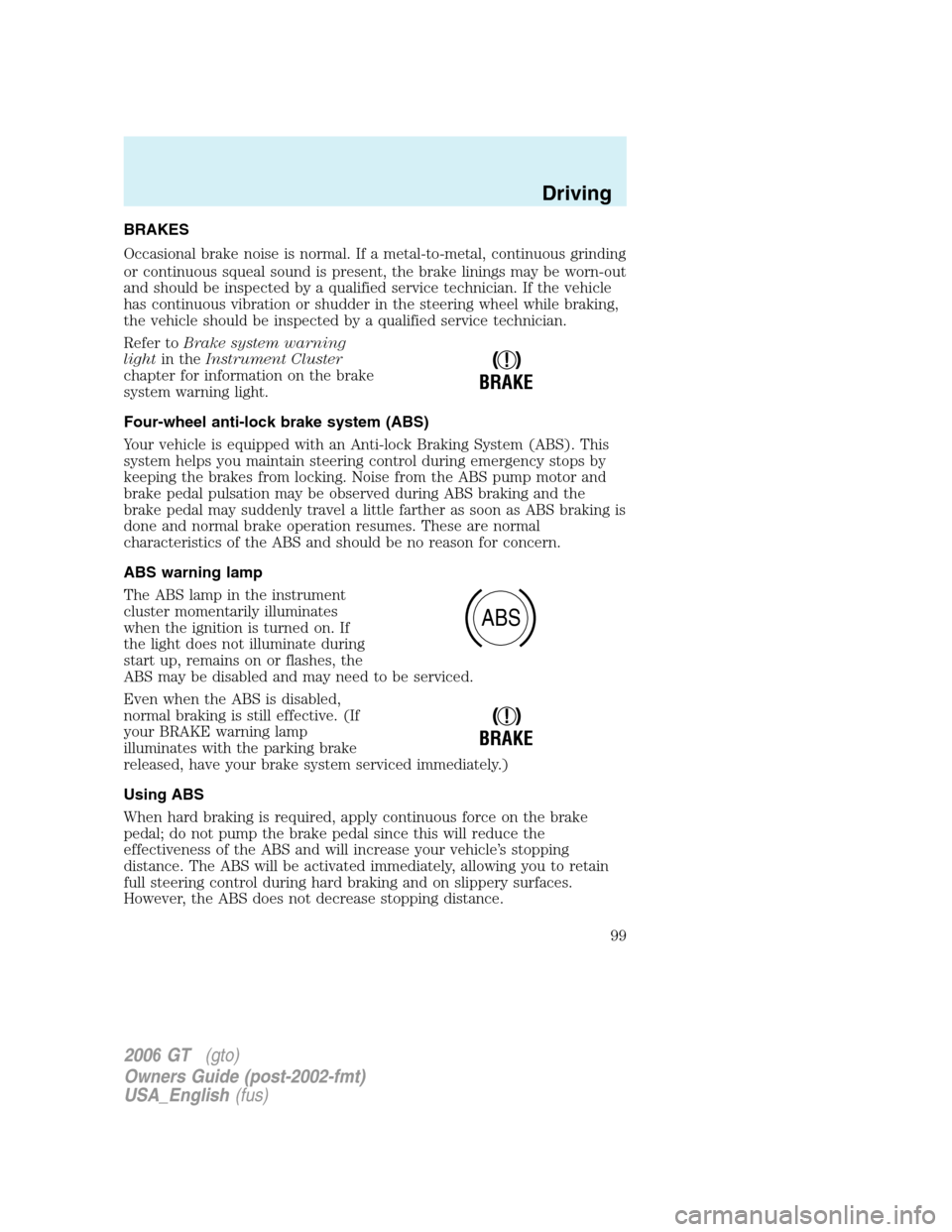
BRAKES
Occasional brake noise is normal. If a metal-to-metal, continuous grinding
or continuous squeal sound is present, the brake linings may be worn-out
and should be inspected by a qualified service technician. If the vehicle
has continuous vibration or shudder in the steering wheel while braking,
the vehicle should be inspected by a qualified service technician.
Refer toBrake system warning
light in the Instrument Cluster
chapter for information on the brake
system warning light.
Four-wheel anti-lock brake system (ABS)
Your vehicle is equipped with an Anti-lock Braking System (ABS). This
system helps you maintain steering control during emergency stops by
keeping the brakes from locking. Noise from the ABS pump motor and
brake pedal pulsation may be observed during ABS braking and the
brake pedal may suddenly travel a little farther as soon as ABS braking is
done and normal brake operation resumes. These are normal
characteristics of the ABS and should be no reason for concern.
ABS warning lamp
The ABS lamp in the instrument
cluster momentarily illuminates
when the ignition is turned on. If
the light does not illuminate during
start up, remains on or flashes, the
ABS may be disabled and may need to be serviced.
Even when the ABS is disabled,
normal braking is still effective. (If
your BRAKE warning lamp
illuminates with the parking brake
released, have your brake system serviced immediately.)
Using ABS
When hard braking is required, apply continuous force on the brake
pedal; do not pump the brake pedal since this will reduce the
effectiveness of the ABS and will increase your vehicle’s stopping
distance. The ABS will be activated immediately, allowing you to retain
full steering control during hard braking and on slippery surfaces.
However, the ABS does not decrease stopping distance.
!
BRAKE
ABS
!
BRAKE
2006 GT (gto)
Owners Guide (post-2002-fmt)
USA_English (fus)
Driving
99
Page 101 of 200
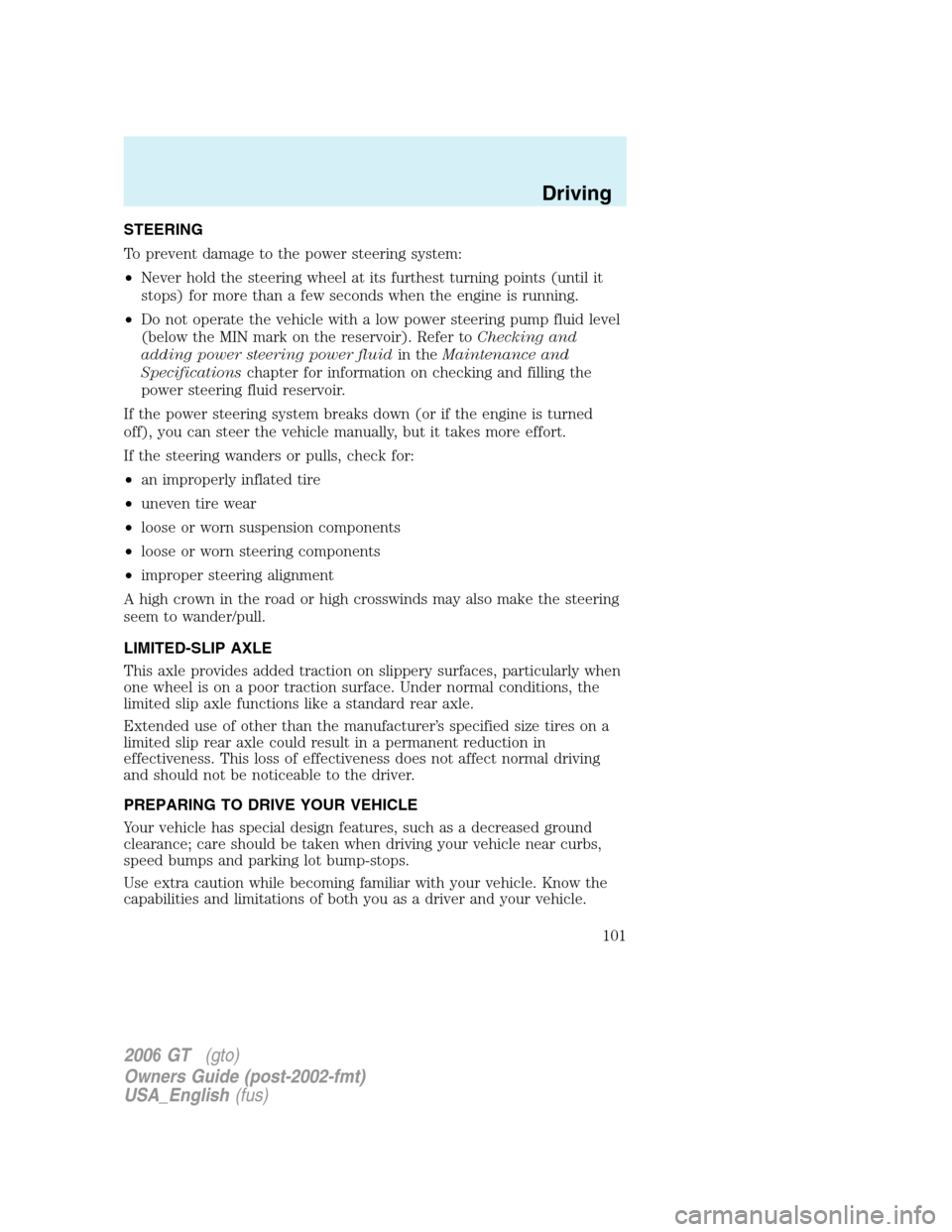
STEERING
To prevent damage to the power steering system:
•Never hold the steering wheel at its furthest turning points (until it
stops) for more than a few seconds when the engine is running.
• Do not operate the vehicle with a low power steering pump fluid level
(below the MIN mark on the reservoir). Refer to Checking and
adding power steering power fluid in theMaintenance and
Specifications chapter for information on checking and filling the
power steering fluid reservoir.
If the power steering system breaks down (or if the engine is turned
off), you can steer the vehicle manually, but it takes more effort.
If the steering wanders or pulls, check for:
• an improperly inflated tire
• uneven tire wear
• loose or worn suspension components
• loose or worn steering components
• improper steering alignment
A high crown in the road or high crosswinds may also make the steering
seem to wander/pull.
LIMITED-SLIP AXLE
This axle provides added traction on slippery surfaces, particularly when
one wheel is on a poor traction surface. Under normal conditions, the
limited slip axle functions like a standard rear axle.
Extended use of other than the manufacturer’s specified size tires on a
limited slip rear axle could result in a permanent reduction in
effectiveness. This loss of effectiveness does not affect normal driving
and should not be noticeable to the driver.
PREPARING TO DRIVE YOUR VEHICLE
Your vehicle has special design features, such as a decreased ground
clearance; care should be taken when driving your vehicle near curbs,
speed bumps and parking lot bump-stops.
Use extra caution while becoming familiar with your vehicle. Know the
capabilities and limitations of both you as a driver and your vehicle.
2006 GT (gto)
Owners Guide (post-2002-fmt)
USA_English (fus)
Driving
101